
Marvel’s Non-Battle Pope Comic: Part I
June 3rd, 2009 by guest article | Tags: james howard, john paul ii, Marvel comics, popeGood evening, gentle readers! My name is James Howard; I like history, and I like comic books, and I am here to talk to you today about both things at the same time.
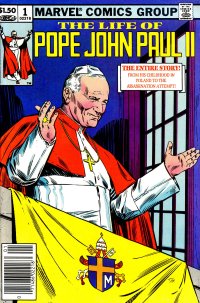
Marvel Comics Presents The Life of Pope John Paul II, 1982 one-shot. Written by Steven Grant, drawn by John Tartaglione, beheld with bewilderment by millions.
This is true: I bought this comic for two dollars, no tax, from the fire sale of a closing Winnipeg comic book store a few years back. I took it home, I read it, and I framed it. Framed it. Because I am a major-league dork.
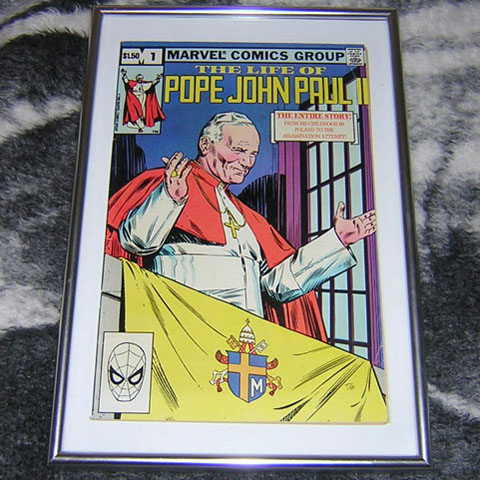
I’m not much for religion, and it’s not an earth-shatteringly great comic (as we’ll get to in a second), but who didn’t have a soft spot for ol’ Pope John Paul II? Dude was like the Catholicism Sara Lee. Passersby and visitors don’t just look at this cover — they stare at it for a few seconds, fishlike and uncomprehending, because honestly what the hell is this.
And given the information you can gleam about it from one glance — comic book, iconic historical figure, single issue — the comic is actually a lot more subdued and grounded than one would originally expect. There’s nothing in here that approaches the funnybook wackiness of Superman punching Muhammad Ali, or Spider-Man using the Socratic Method to foil an exact body double of Barack Obama, or… whatever this was. If they made a comic about the Pope today it would probably be thirty-two pages of Hugh Jackman Wolverine riding a motorcycle through a gunfight in a church in the past, so I guess I’ll take my down-to-earth portrayals where I can get them.
The blurb on the front promises the entire story, “from his childhood in Poland to the assassination attempt”, so it’s only natural that the comic starts with… uh, with this guy.
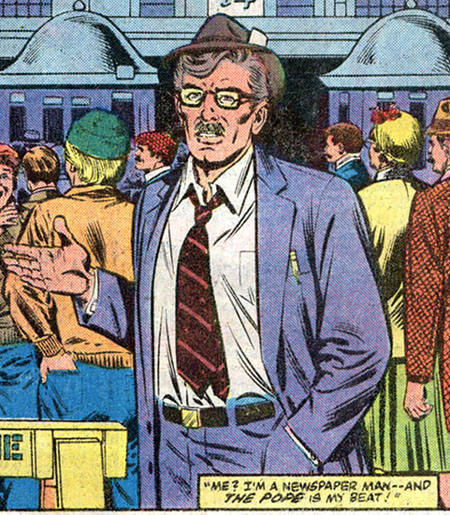
“I bet you’re jealous!”
Yes, our story begins with a self-proclaimed newspaper-man, and in lieu of an actual name — because the comic never gives us one — I figure we’ll just go ahead and call him ‘Scoop’. So Scoop here is tasked with attending and covering Pope John Paul II’s famous Yankee Stadium speech in 1979, and he moves the story along by monologuing his way up to his seat.
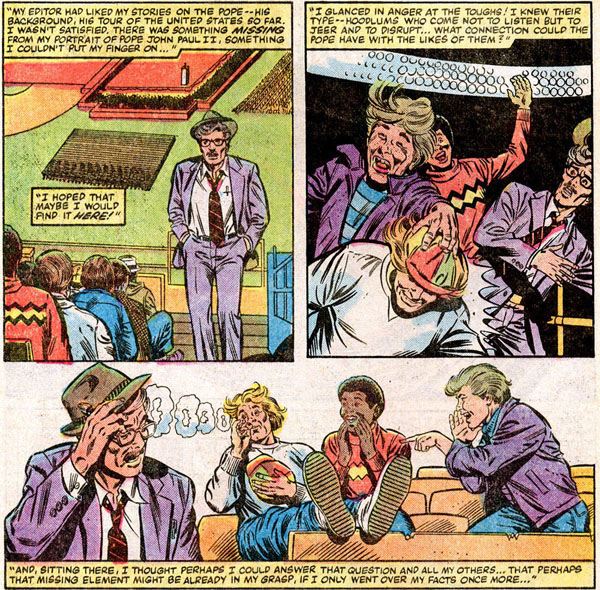
“I glanced in anger at the toughs!” You tell ’em, Scoop! New York in 1979 must not have been nearly as tough as I would have imagined if the average hoodlum was a kid in a Charlie Brown sweater who giggles with his hands in front of his face.
But yes, this is our setup; most of the rest of the comic is spent inside of Scoop’s head, as a straightforward journalistic account of the Pope’s life to date. The bulk of the text is the biographical narrative in those little yellow boxes, as we watch John Paul’s life flash before our eyes. Join us, won’t you?
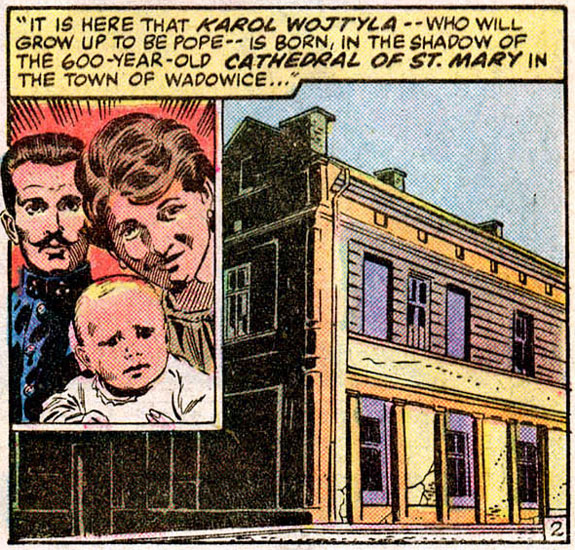
The future Pope John Paul the Second was born May 18th, 1920, in the small southern Polish town of Wadowice. He was given the name of Karol Jozef Wojtyla, and was apparently the son of Tommy from Apartment 3-G and the guy on the Pringles can. WHERE YO CURLY MOUSTACHE
Little Karol is shown listening excitedly to the mass bells, but we’re told that he’s no more or less religious than anyone else in Poland; we get some scenes of him learning excitedly and helping out at mass and generally being the perfect little kid, to the chagrin of his classmates.
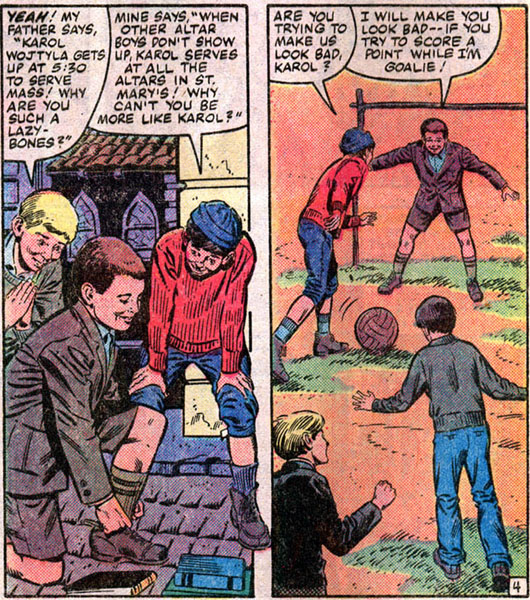
Ho-hoooooooo, snap! It may seem tame by today’s standards, but I assure you that in its original Polish this was very strong trash talk in the 1920s. If Karol Wojtyla were a young lad growing up today he would be on some playground doing this or this or this, and then he would never grow up to be Pope because somebody would wedgie him to death.
Karol leads a reasonably happy, uneventful childhood until the death of his mother at age nine, which of course is sad, but the effect on the audience is lessened by A) her only speaking once in the entire book and B) the grief immediately transmogrifying his father into J. Jonah Jameson.
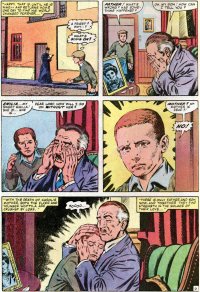
You see what I mean. Think of how much more touching this scene would have been if I weren’t reading it with Jameson’s voice in my head!
“Emilia… my sweet Emilia! Fuck you! Get me a fucking coffee!”
Even still, geez, poor kid. He mourns for a while and eventually moves on, playing soccer and letting classmates copy his notes and being the best kid around; life goes well for exactly one page before he hits the age of twelve and his older brother, a doctor in another town, catches scarlet fever and dies. Karol, works through the grief by joining the acting troupe that his brother participated in, which gives us this bit of interaction that will be important later:
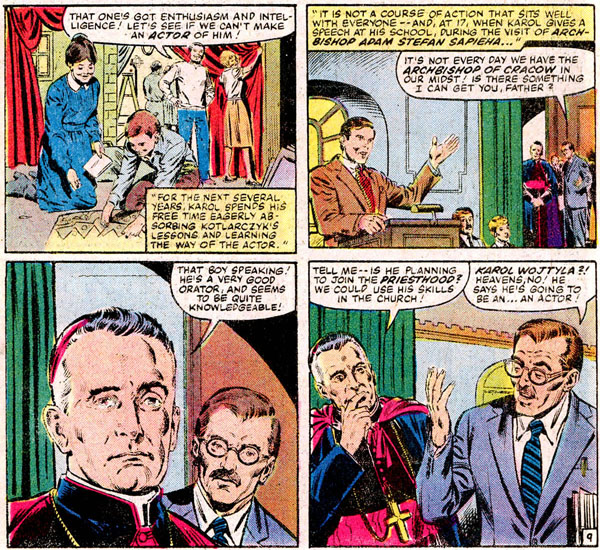
Oh, well, that’s the end of that, then.
The dueling paths of stage and clergy remain a consistent theme throughout the comic, but for now we follow Wojtyla as he matures to adulthood. He and his father move to Cracow (which I’ve always spelled ‘Krakow’, but let’s roll with it) so that he may further his acting and studies at University; the only problem is that it’s 1938 by this point, and, well, you know.
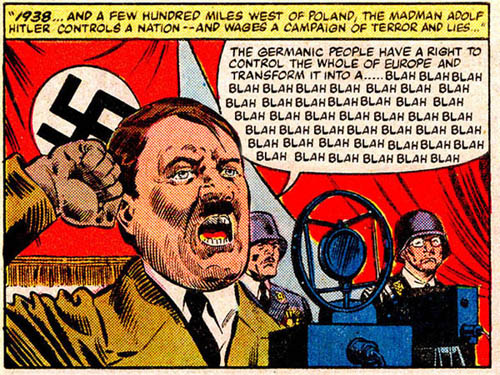
This is an exact translation of his speech, by the way. Not a lot of people know that. About five minutes in he switched to those ‘mwop-mwah’ noises the adults make in the Peanuts cartoons.
So Germany commences the bombing of Poland by September of the next year, and by the end of that September Poland has been conquered and split up between the new alliance of Germany and Russia. Wojtyla at this time is among a trail of refugees, heading eastward to meet up with the Polish army; when his trail of Polish refugees heading east to get away from the Germans runs into a trail of Polish refugees heading west to get away from the Russians, two and two are put together and Wojtyla returns to Cracow where he believes he can do the most good for his country.
To this point the comic has been largely dry and disengaged in its retelling of the future Pope’s young life, but in this particular sequence of events there is the one page that always sticks with me:
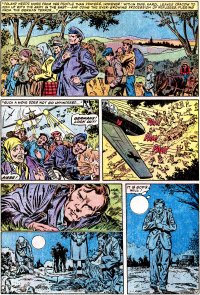
Despite the usually maligned medium that this biography is presented in, there is a deliberate dedication on the part of everyone involved to making sure that the story is factually accurate. The inside back cover of the comic attributes much of the information inside to Marvel’s communications with Father Mieczyslaw Malinski, one of Wojtyla’s fellow seminary students and closest longtime confidants; the back copy claims that this relationship allows the comic to present stories “that have never before been told to the general public in any medium”, adding that “True insights and facts about Pope John Paul II are told for the first time in this Marvel magazine.” The exclusivity claim might be a little much, given that Malinski has written at least two dozen Polish-language books about his buddy the Pope — and in fact, the legal information at the front of the book grants the full text copyright to Malinski — but the important thing to take from this knowledge is that the anecdotes and recollections included in this book are true and accurate. Pope John Paul the Second probably didn’t feel the need to lie about his history, and Malinski probably didn’t feel the need to lie about what the Pope said.
(Malinski was also one of the authorities contacted to debunk a longstanding chess myth about the Pope, which is a sentence you don’t see written everyday. He also may or may not have collaborated with the communist secret police, but that’s a different story entirely.)
That may have been a bit rambly, so what I’m getting at is that the above — if true, and we have no reason to believe otherwise — is the first really important insight that we get into Wojtyla’s makeup and an experience that contributes to the mystique surrounding him. Some people lead boring lives, and some people lead amazing, captivating, infinitely interesting lives. (They don’t always drink beer, but when they do, they prefer Dos Equis.)
Japanese professional wrestler Antonio Inoki founded a discipline of full-contact karate, fought Muhammad Ali to a draw in a legitimate mixed-martial-arts exhibition, served for six years in the Japanese legislature, and was given a pair of golden swords by Saddam Hussein when he visited Iraq to negotiate the release of prisoners prior to the first Gulf War. Children’s author and poet Shel Silverstein (of “Where the Sidewalk Ends”) also found fame as a wildly successful country-western singer-songwriter, most notably winning a Grammy for writing Johnny Cash’s “A Boy Named Sue”. Children’s author Roald Dahl (of “Matilda”, “The BFG” and “The Witches”) was a World War II flying ace and an MI-6 secret agent; his family buried him with a a set of Ticonderoga pencils, a pool cue, a bottle of burgundy and a power saw. Karol Jozef Wojtyla, the future Pope John Paul II, was among a group of Polish refugees when they were gunned down by a Nazi fighter plane, and the only way that he could justify and explain his own survival among the deaths of countless others was to reassure himself that it was God’s will. That is completely and utterly fascinating, and my role today is to sit here and ruin it with Batman jokes.
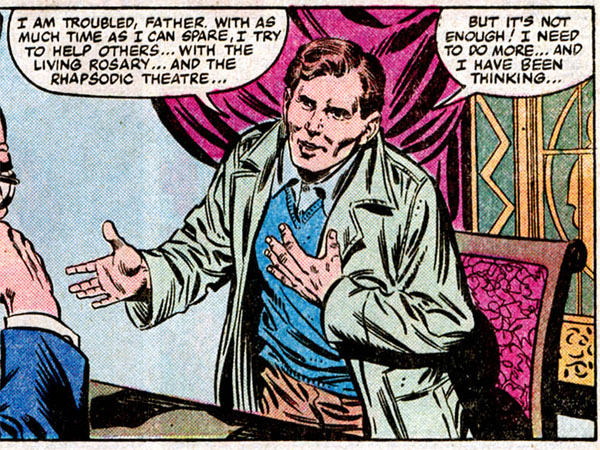
I SHALL BECOME A BAT
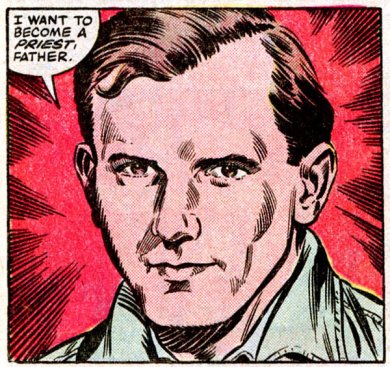
FINE CLOSE ENOUGH
Wojtyla returns to Cracow and works as a forced labourer under the Nazi occupation of Poland, secretly co-founding and performing in the underground Rhapsodic Theatre; after the death of his father in 1941, and after a German military truck hits and hospitalizes him, he turns increasingly to his faith for peace of mind until he ultimately decides that his best contribution to preserve the Polish spirit would be as a priest.
His friends take the news well!
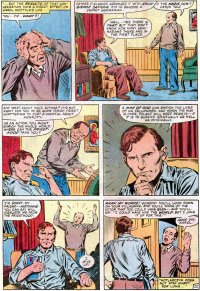
The other fellow in this scene is Mieczyslaw Kotlarczyk, the leader of the theatre troupe Wojtyla joined as a youth and the other co-founder of the Rhapsodic Theatre. Couldn’t tell from the page above that he’s an actor, could you? Ha!
So Wojtyla works at the factory in the day and studies secretly to become a seminarian, until the Warsaw worker revolts of 1944 spook the Germans into suspecting that a nationwide rebellion is coming. To ensure that no revolution ensues, the German army rounds up and detains all able-bodied men in Cracow; Wojtyla escapes capture when they fail to search his whole house, and his priest later tracks him down to sneak him to a hiding place.
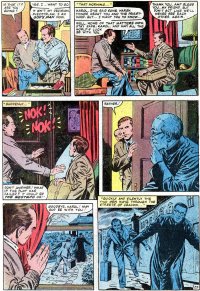
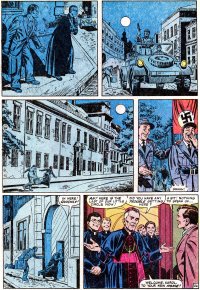
Tactical Espionage Action: Metal Gear Poland! And look who it is — our buddy from before, Archbishop of Krakow Adam Stefan Sapieha, who himself was a pretty interesting guy. The Archbishop harbours Wojtyla and at least a dozen other young men in his house until the Russians finally show up and chase the Nazis out of Poland in 1945, at which point the priests are able to go out and start helping out around town.
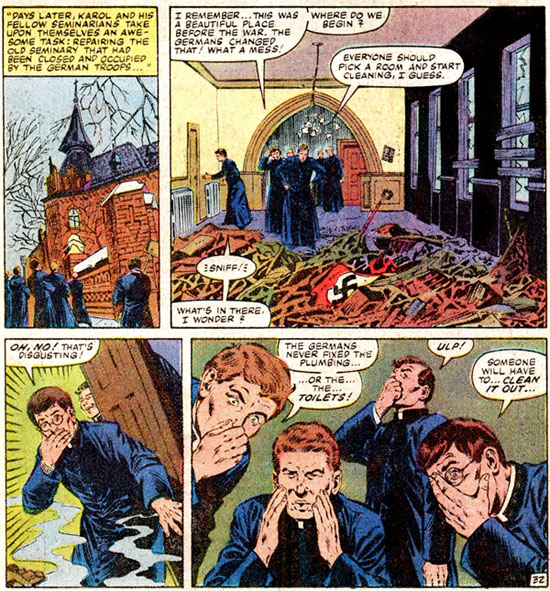
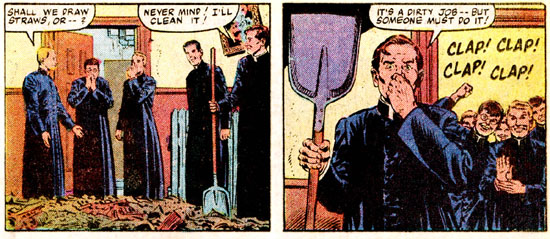
It was only Earth-616 Karol Wojtyla that went on to become the Pope, as it turns out. Ultimate Wojtyla found an equally rewarding calling in his eventual role as the Poopsmith.
Poland shakes off its Nazi chains, stretches its legs, and is free and independent for like ten minutes before the Yalta conference basically hands Russia the keys to the place. This turn of events made Poland a little discouraged, which is like saying the Legacy Virus made Colossus a little sick. Wojtyla is finally officially ordained by the Archbishop as a priest of the Catholic Church, spends a bit of time studying in Rome at the Archbishop’s behest, and returns to begin educating the youth of the nation.
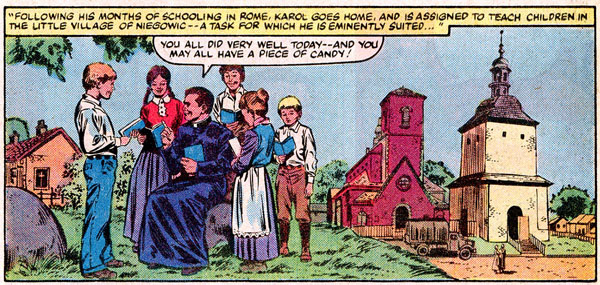
Oh. Hoo, boy. Well. This is a scene from a different era, that’s for sure.
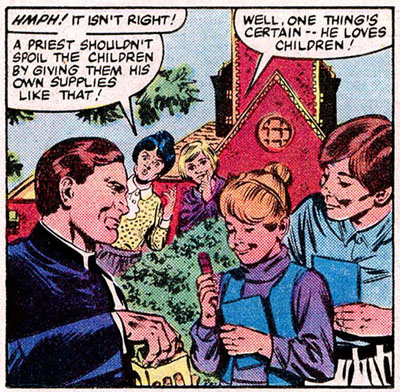
Ladies, you’re not helping.
Wojtyla returns to Cracow and has collections of the poetry he has written secretly over the past twenty years published in the newspaper, under a pen name, to great acclaim. No, seriously.
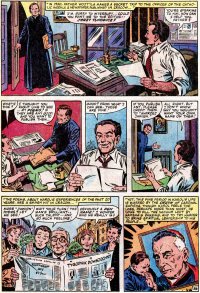
Look at that impish little face he’s striking in the bottom left, too. “Yes, who could this brilliant and no doubt devastatingly handsome poet be? The world may never know!”
It’s around this point in the comic — just over half way through the book — that the narrative really starts skipping like a stone on a lake. It’s 1950 on the page above; the page immediately following it is an anecdote about traveling with a friend and being berated by a farmer for not wearing the proper religious attire; and then the page after that, boom, it’s 1956.
“I’m sending you to Rome!” “Rome?” And then next panel, yep, he’s in Rome — for two panels, then in Niegowicz for two panels, and then suddenly he’s right back where he started. This is partially due to the nature of the medium, I suppose, and probably due in large part to the size constraints of the book, but it still leads to some jarringly sudden transitions as the book progresses.
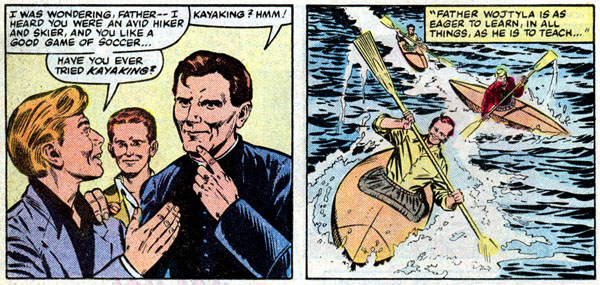
You see what I mean. Not hard to talk him into things, is it?
He’s on one such kayaking adventure in 1956, leading an outing with his students, when the new cardinal sends some dudes up the mountain to fetch him and tell him that he’s going to be the next Archbishop of Cracow as soon as he gets out of the damn kayak and gets back into town.
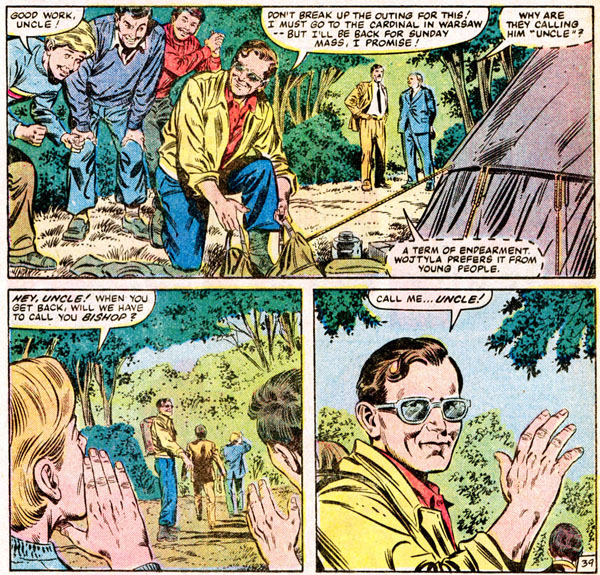
“Uncle Fashion!”
“Yeah, uh… no thanks.”
Whatever else Hunter S. Thompson may have thought of the Catholic Church, at least we know now who he patterned his personal style off of.
Click here for part two! Featuring bears! Chefs! Assassinations! And more!

My Dad had this!!
I remember him picking it up at my Local Shop’s back issue bin for about a quid. I can’t find it anywhere now, I think he gave it to my Gran as a joke gift. I’d love to get another copy, it’s just too odd to exist! Like the Billy Ray Cyrus book Marvel did.
I’d like to see the current Pope (a former Hitler Youth) versus Nick Fury and his Howling Commandos! It’d be epic!
I think I’d rather read an article on Battle Pope, if it’s all the same to you.
I bought this comic in 1982! I was 12 years old and my friend and I chipped in and bought this comic one day at our comic store. We bought it telling each other that someday it was going to be worth alot of money, so we carefully enclosed it in a comic sleeve and I put it in my comic box. Fast forward 27 years and I still have this comic, though I have lost touch with my friend. How much is it worth now? No idea. Too much trouble to try and sell it anyway